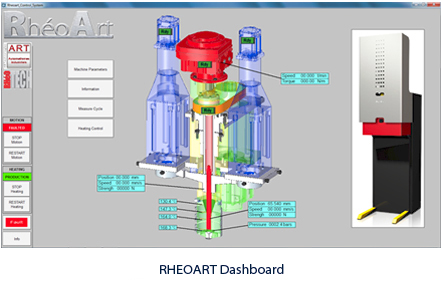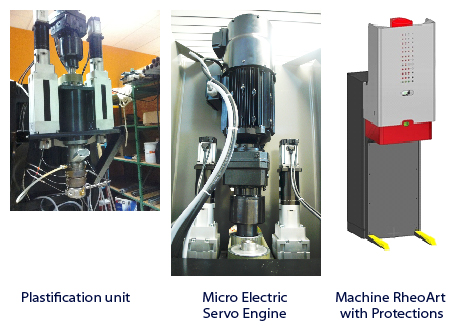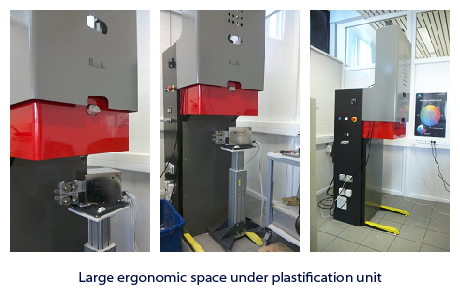Rheology Systems for Research and Development Laboratories - Technology Applications Forming materials and polymers - Materials Quality control
Version françaiseThe origin of RhéoArt
WHY RHÉOART ? – DEVELOPMENTS AND EXPERIENCES
The Rhéoart is the culmination of more than 35 years of expertise in Research and Development laboratories with rheology and shaping of polymers.
The current RhéoArt have been developed by the group of plasturgist & developers from ARTECHNOLOGIES France in close collaboration with the specialists of CEMEF / ENSMP from Sophia Antipolis.
The overall design of the plasticizing unit is a total innovation in the field of rheology.
The accuracy of the material processing and measured parameters go well beyond the current parameters
established with a capillary traditional rheometer, especially for materials such as PVC / PVC rigid.

High Precision and Speed !

Fully electric, the RhéoArt combines the strength to the precision to reach a quasi instantaneous
transformation of the polymers.
This advanced control combined with the revolutionary mechanical changes of the plastification unit allows:
- - A very short thermomecanical post of the matter created by a epicycloidal shear of a unique technology.
- - A flexible adjustment of the shear force down to unforeseen rates with conventional rheometers.
- - A programmable multi-step cycle with automatic switch.
advantages
- - Dynamic Rheology (Rotary plane/plane or cone/plane setup) allows rheologic analysis of fluids in small deformation (linear domain) or a large frequency panel.
- - Capillary Rheology allows viscosity measurements on large deformation in close to industrial process conditions.
- - In homogeneous systems (melted polymers), it has been demonstrated that the dynamic viscosity can be overlaid to the capillary viscosity according to the shear rate. This is called the "Cox-Merz" analogy.
- - Capillary rheology is therefore essential to study complex fluid materials where the Cox-Merz analogy do not apply.
PVC, incompatible polymers mix, loaded polymers elastomers or agroalimentary formulas for example require this new type of approach.
Often, rheological measurement is complex or impossible for these products in conventional rheometer for the following reasons:
- Heating time (plastification and fusion) incompatible with its thermal stability without addition of stabilizers that may interfere with the measured rheological behavior.
- A complex loading of the mater reserves of the capillary rheometer that leads to air trapping, seen in the perturbed pressure signals.
Furthermore, conventional rheometer measure viscosity in large deformation conditions, the plastification/fusion operates exclusively by heat conduction, while it is the dissipated energy during the matter flow which is the main factor for plastification/fusion in most industrial transformation process (polymers, thermoplastics, elastomers, agroalimentary matters).
The fusion operated by the rheoplast is therefore much faster than in a conventional capilary rheometer, reducing thereby the measurement time.
Moreover, for materials sensitive to thermomechanic treatments, conventional capillary rheometer overestimate significantly the actual viscosity in the flow.
In the case of Amylaced products, a simple heating on the material without melting it is not efficient. Here, conventional capillary rheology is inadapted to study the behavior in a plastified form. To overcome this limitation, scientists and industrials have developed “extrusiometers” or “instrumented nozzles”, consisting in adapting a capillary head to an extruding unit or a plastification unit of an injecting press.
This allows an efficient measurement of the viscosity close to injection conditions. However, the “thermomecanic history” of the material is complex and the consumption of material to obtain proper viscosity curves, can reach several kilograms.
Therefore the idea of the Rheoplast, consisting in decoupling in a simple geometry the thermomecanic history that melts and plastify the material in a limited time and the capillary rheologic measurement.


